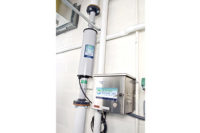The building's usefulness as an immigration-processing center ended in 1974, and it was closed again. Time, neglect, and the caustic sea air brought the tower to disrepair and near ruin. In 1997, the Freedom Tower Foundation purchased the building and began a massive $40 million renovation to transform the 85,000-sq-ft building into a monument to liberty and the Cubans' struggle for freedom. Plans called for a museum dedicated to the Cuban exodus, an art exhibition center, an auditorium, and a library to document Cuban history.
A Cool National Monument
To bring the building to today's standards, the restoration also called for air conditioning all 16 floors. According to Puig, this posed a unique challenge. "The Freedom Tower was not built for air conditioning, which in itself is not unusual for buildings of this age," he said. "But the building is designated a national monument, so our bigger challenge was to renovate the property while keeping it as close as possible to its original design. That meant keeping HVAC equipment as unobtrusive as possible while still providing modern conditions."Puig worked with Art Alfonso of McQuay Caribe, Catano, Puerto Rico, to develop a cooling system that would meet the 270-ton building load and fit in the limited space available in the historic building.
A third criterion for the chiller was to have separate steps of capacity reduction. Puig selected the McQuay ALS 270 air cooled screw chiller not only because it met building load and space requirements, but also because it has three independent circuits.
"In the event of a compressor failure, there would still be two-thirds of total capacity available to maintain building conditions 80% of the time. In comparison, most other manufacturers offer only two circuits, which means losing 50% of capacity in the event of failure," says Alfonso.
Once the chiller type was determined, the next obstacle was finding a space for it. Puig and Alfonso located space on the third-level roof outside the library that was out of the way, yet allowed ample room for maintenance and easy connection to the AHUs. "Because the chiller has an industry-low sound pressure level of just 74 dBa, it can operate in that location without disturbing building occupants or neighbors."
"Many of the areas in the Freedom Tower are extremely narrow," Puig says, "so getting most manufacturers' air handlers into the building would have been impossible." Eight modular McQuay Vision air handlers were installed in the building to handle the required load.
"It's no overstatement to say that the Vision air handlers made the entire installation possible," Puig said. "The air handlers provide a custom-modular platform for configuring optimal air handling systems without the high price of customized units."
Allowing easy access to equipment for maintenance was another important consideration. The McQuay AHUs allow coils to be removed from the unit through the top, the side, or a combination of both without disassembling the entire coil section, providing the Freedom Tower engineers with maximum flexibility in system design.
A Final Hurdle
Miami's sea climate provided one final hurdle. "The salty Biscayne Bay air is so harsh that over time it had corroded the Freedom Tower's original steel rebars," Puig says. "In this type of environment, the cooling coils in the air handlers wouldn't last long, but McQuay cooling coils are available with a special baked-on coating to safeguard against corrosion. We knew the treated coils would withstand the harsh climate," said Puig.Puig anticipates the new occupants will benefit from the building's historic spirit as well as its modern comforts. "The McQuay equipment gave us the freedom we needed to install it in a very challenging environment, and freedom is what the Freedom Tower is all about."ES









